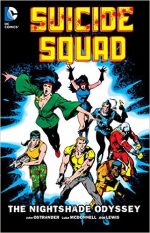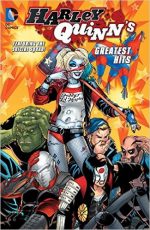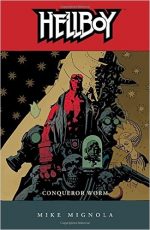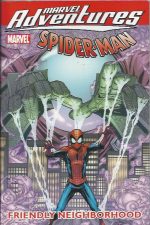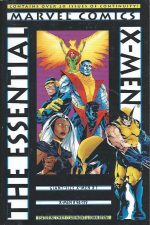

By Len Wein, Chris Claremont, Bill Mantlo, Dave Cockrum, John Byrne, Bob Brown, Tony DeZuniga & various (Marvel)
ISBN: 978-0-7851-2376-7
In 1963 The X-Men #1 introduced Scott “Cyclops†Summers, Bobby “Iceman†Drake, Warren “Angel†Worthington, Jean “Marvel Girl†Grey and Hank “The Beast†McCoy: very special students of Professor Charles Xavier.
He was a wheelchair-bound telepath dedicated to brokering peace and integration between the masses of humanity and the emergent off-shoot race of mutants dubbed Homo Superior; considered by many who knew him as a living saint.
After nearly eight years of eccentric and spectacular adventures the mutant misfits disappeared at the beginning of 1970 during another periodic downturn in superhero comics. Just like in the closing years of the 1940s, mystery men faded away as supernatural mysteries and traditional genre themes dominated the world’s entertainment fields…
Although their title was revived at the end of the year as a cheap reprint vehicle, the missing mutants were reduced to guest-stars and bit-players throughout the Marvel universe, whilst the bludgeoning Beast was opportunistically transformed into a monster to cash in on the horror boom.
Then, with sales of the spooky stuff waning in 1975, Marvel Editor-in-Chief Roy Thomas green-lighted a bold one-shot as part of the company’s line of Giant-Size specials and history was made…
This groundbreaking monochrome monolith of mutant mayhem first appeared in 1996, offering an economical, phonebook (remember those?) sized mass-market collection for newbies and neophytes catch-up to the sun-bright excitement of those exuberant and pivotal early stories.
Collecting Giant Size X-Men #1 and issues #94-119 of the definitely “All-New, All-Different†X-Men (spanning May 1975 to March 1978), this titanic tome traces the reinvigorated merry mutants from young, fresh and delightfully under-exposed innovations to the beginnings of their unstoppable ascendancy to ultimate comicbook icons…
Without pause or preamble, the epic voyage begins with a classic mystery monster mash from Giant Size X-Men #1. In ‘Second Genesis!’ Len Wein & Dave Cockrum (the artist hot from his stint reviving DC’s equally eclectic fan-fave super-team The Legion of Super-Heroes) detailed how the original squad – sans new Avengers recruit The Beast – had been lost in action, leaving Xavier to scour Earth and the entire Marvel Universe for replacements.
To old foes-turned-friends Banshee and Sunfire was added a one-shot Hulk adversary dubbed the Wolverine, but the bulk of time and attention was lavished upon original creations Kurt Wagner, a demonic-seeming German teleporter codenamed Nightcrawler, African weather “goddess†Ororo Monroe AKA Storm, Russian farmboy Peter Rasputin who could turn into a living steel Colossus and bitter, disillusioned Apache superman John Proudstar who was cajoled into joining the makeshift squad as Thunderbird.
The second chapter of the epic introductory adventure ‘…And Then There Was One!’ reintroduced battered, depleted but unbowed team-leader Cyclops who swiftly drilled the newcomers into a semblance of readiness before leading them into primordial danger against the monolithic threat of ‘Krakoa… the Island That Walks Like a Man!’
Overcoming the phenomenal terror of a rampaging rapacious mutant eco-system and rescuing the “real†team should have led to another quarterly Giant-Size issue, but so great was the groundswell of support that the follow-up adventure was swiftly reworked into a two-part tale for the rapidly reconfigured comicbook which became a bimonthly home to the new team.
Those epic beginnings are supplanted by a trio of vignettes explaining how the heroes’ formidable abilities function, beginning with ‘Call Him… Cyclops’ from X-Men #43, revealing the secrets of his awesome eye-blasts in pithy quickie by Thomas, Werner Roth and John Verpoorten whilst Stan Lee, Arnold Drake, Roth & Verpoorten performed similar duties with ‘I, the Iceman!’ from #47.
Finally, from X-Men #57 comes a chattily entrancing rundown describing Marvel Girl’s psionic abilities in ‘The Female of the Species!’ from Thomas, Roth & Verpoorten.
X-Men #94 (August 1975) offered ‘The Doomsmith Scenario!’ – plotted by Editor Wein, scripted by Chris Claremont and with Bob McLeod inking man-on-fire Dave Cockrum – in a canny Armageddon-shocker as the newly pared-down strike-squad (minus Sunfire and still-recuperating Marvel Girl, Angel, Iceman, Havok and Lorna Dane) were despatched by the Beast – calling in a favour from Avenger’s HQ – to stop criminal terrorist Count Nefaria starting an atomic war.
The insidious mastermind had invaded America’s Norad citadel with a gang of artificial superhumans and accidentally escalated a nuclear blackmail scheme into an inescapable countdown to holocaust, leaving the untrained, unprepared mutants to storm in to save the world in epic conclusion ‘Warhunt! (inked by Sam Grainger).
One of the new team didn’t make it back…
X-Men #96 saw Claremont take charge of the writing (albeit with some plotting input from Bill Mantlo) for ‘Night of the Demon!’ Guilt-wracked Cyclops blamed himself for the loss of his team-mate, and in his explosive rage accidentally unleashed a demonic antediluvian horror from earth’s dimmest prehistory for the heroes-in-training to thrash.
The infernal Nagarai would return over and again to bedevil mankind, but the biggest innovation in this issue was the introduction of gun-toting biologist/housekeeper Moira MacTaggert and the first inklings of the return of implacable old adversaries…
Issue #97 started a long-running, cosmically-widescreen storyline with ‘My Brother, My Enemy!’ as Xavier, tormented by visions of interstellar war, tried to take a vacation, just as Havok and Lorna (finally settling on superhero nom de guerre Polaris) attacked: apparently willing servants of a mysterious madman using Cyclops’ old undercover alter ego Eric the Red.
The devastating conflict segued into a spectacular, 3-part saga as pitiless robotic killers returned under the hate-filled auspices of mutantophobic Steven Lang and his mysterious backers of Project Armageddon. The action began with #98’s ‘Merry Christmas, X-Men…the Sentinels Have Returned!’
With coordinated attacks capturing semi-retired Marvel Girl plus Wolverine, Banshee and Xavier, Cyclops and the remaining heroes had to co-opt a space shuttle and storm Lang’s orbital HQ to rescue them in ‘Deathstar Rising!’ (inks by Frank Chiaramonte): another phenomenal all-action episode.
Accompanied by a magical pinup of portraits by Cockrum, the saga concludes on an agonising cliffhanger with the 100th issue anniversary tale. ‘Greater Love Hath no X-Man…’ (with Cockrum inking his own pencils) sees the new X-Men apparently battle the original team before overturning Lang’s monstrous schemes forever.
However, their catastrophic clash had destroyed the only means of escape and, as a colossal solar flare threatened to eradicate the satellite-station, the only chance of survival meant certain death for another X-Man.
As #101 unfolded, scripter Claremont & artist Cockrum were on the on the verge of utterly overturning the accepted status quo of women in comics forever…
The team consisted of old acquaintance and former foe Sean “Banshee†Cassidy, Wolverine, and new creations Nightcrawler, Storm and Colossus, led by field-leader Cyclops and part-timer Jean Grey – still labouring under the nom-de guerre Marvel Girl… but not for much longer…
‘Like a Phoenix from the Ashes’ (inked by Frank Chiaramonte) saw a space-shuttle spectacularly crash into Jamaica Bay. The X-Men had safely travelled in a specially-shielded chamber but Marvel Girl had to needed manually pilot the vehicle, unprotected through a lethal radiation storm.
As the mutants fled the slowly sinking craft, a fantastic explosion propels the impossibly alive Jean into the air, clad in a strange gold and green uniform and screaming that she is “Fire and Life Incarnate… Phoenix!â€
Immediately collapsing, the critically injured girl is rushed to hospital and a grim wait begins.
Unable to explain her survival and too preoccupied to spare time for teaching, Xavier packs Banshee, Nightcrawler, Wolverine, Storm and Colossus off to the Irish mutant’s home in County Mayo for a vacation, blissfully unaware that Cassidy Keep has been compromised and is now a deadly trap for his new students…
Within the ancestral pile, Sean’s mutant cousin Black Tom has usurped control of the manor and its incredible secrets before – at Eric the Red’s behest – contriving an inescapable ambush, assisted by an old X-Men enemy.
‘Who Will Stop the Juggernaut?’ (Grainger inks) sees the inexperienced heroes in over their heads and fighting for their lives, but still finds room to reveal the origins of Storm and provide an explanation for her crippling claustrophobia, before ‘The Fall of the Tower’ cataclysmically concludes the tale with mutant heroes and the Keep’s Leprechaun colony (no, really!) uniting to expel the murderous usurpers.
Although bi-monthly at the time, the series kicked into confident top gear with ‘The Gentleman’s Name is Magneto’ as the weary warriors then divert to Scotland to check on Moira MacTaggert’s island lab: a secret facility containing many mutant menaces the X-Men have previously defeated.
It’s a very bad move since the ever-active Eric has restored the dormant master of magnetism to full power. The mutant terrorist had been turned into a baby – a strangely common fate for villains in those faraway days – but was all grown up again now… and indulging in one last temper tantrum…
Freshly arrived from America, Moira and Cyclops are only just in time to lead a desperate, humiliating retreat from the triumphant Master of Magnetism. Scott doesn’t care: he realises the entire affair has been a feint to draw the heroes away from Xavier and Jean…
He needn’t have worried. Although in ‘Phoenix Unleashed’ (inks by Bob Layton) Eric orchestrated an attack by Firelord – a cosmic flamethrower and former herald of Galactus much like the Silver Surfer – Jean is now fully evolved into a being of unimaginable power who readily holds the fiery marauder at bay…
In the interim a long-standing mystery is solved as the visions which had haunted Xavier are revealed as a psychic connection with a runaway princess from a distant alien empire. Lilandra of the Shi’ar had rebelled against her imperial brother and whilst fleeing had somehow telepathically locked onto her trans-galactic soul-mate Xavier.
As she made her circuitous way to Earth, embedded Shi’ar spy Shakari had assumed the role of Eric the Red and attempted to remove Lilandra’s potential champion before she arrived…
During the blistering battle which follows the X-Men’s dramatic arrival, Shakari snatches up Lilandra and drags her through a stargate to their home galaxy, and with the entire universe imperilled, Xavier urges his team to follow. All Jean has to do is re-open a wormhole to the other side of creation…
A minor digression follows as overstretched artist Cockrum gains a breather via fill-in “untold†tale of the new team featuring an attack by psychic clones of the original X-men in ‘Dark Shroud of the Past’ (by Bill Mantlo, Bob Brown & Tom Sutton, inside a framing sequence from Cockrum).
The regular story resumes in a wry tribute to Star Trek as ‘Where No X-Man Has Gone Before!’ (Claremont, Cockrum & Dan Green) finds the heroes stranded in another galaxy where they meet and are defeated by the Shi’ar Imperial Guard (an in-joke version of the Legion of Super Heroes), until bold interstellar rebel/freebooters the Starjammers bombastically arrive to turn the tables again and uncover a mad scheme to unmake the fabric of space-time.
Lilandra’s brother Emperor D’Ken is a deranged maniac who wants to activate a cosmic artefact known alternatively as the M’Kraan Crystal and “the End of All that Is†in his quest for ultimate power. He’s also spent time on Earth in the past and played a major role in the life of one of the X-Men…
This tale (from issue #107) was Cockrum’s last for years. He would eventually return to replace the man who replaced him. John Byrne not only illustrated but also began co-plotting the tales and as the team roster expanded the series rose to even greater heights. It would culminate in the landmark “Dark Phoenix†storyline which saw the death of arguably the book’s most beloved and imaginative character and the departure of the team’s heart and soul. The epic cosmic saga also seemed to fracture the epochal working relationship of Claremont and Byrne.
Within months of publication they went their separate ways: Claremont staying with the mutants whilst Byrne moved on to establish his own reputation as a writer on series such as Alpha Flight, Incredible Hulk and especially his revolutionised Fantastic Four…
There and then though, the X-Men and Starjammers battled the Crystal’s astoundingly deadly automated guardians, as this final chapter saw the newly puissant Phoenix literally save Reality in a mind-blowing display of power and skill.
Trapped inside a staggering other-realm, and appalled and enthralled by the intoxicating, addictive nature of her own might, Phoenix rewove the fabric of Reality and for an encore brought the heroes home again.
The conclusion of this ambitious extended saga was drawn by Byrne and inked by Terry Austin and their visual virtuosity was to become an industry bench-mark as the X-Men grew in popularity and complexity.
However, even though the bravura high-octane thrills of “Armageddon Now†seemed an unrepeatable high-point, Claremont & Byrne had only started. The best was still to come…
In ‘Home Are the Heroes!’ Wolverine finally began to develop a back-history and some depth of character as technological wonder Weapon Alpha attacked the recuperating team in an attempt to force the enigmatic Logan to rejoin the Canadian Secret Service. Renamed Vindicator Alpha would later return with Alpha Flight – a Canadian super-team which would eventually graduate to their own eccentric high-profile series.
Next follows a rather limp and hasty fill-in as ‘The “Xâ€-Sanction’ (illustrated by Tony DeZuniga & Cockrum), sees cyborg mercenary Warhawk infiltrating the mansion in search of “intel†for a mysterious, unspecified master before getting his shiny silver head handed to him…
After a magical pinup of the extended team by Arthur Adams (the cover of Classic X-Men #1 from 1986) the saga got back on track with ‘Mindgames’ (Claremont, Byrne & Austin) as Beast visits a circus in search of the new team which has been missing for weeks.
His presence disrupts a devilish scheme by Mesmero to subjugate the mutant heroes through false memories and implanted personalities but the reawakened team’s vengeance is forestalled when their greatest enemy ambushes them…
In X-Men #112 they fight and fail leaving ‘Magneto Triumphant!’ and his enemies helplessly imprisoned miles beneath Antarctica in the follow-up ‘Showdown!’ However, by the time the Homo Superior tyrant returns after terrorising the humans of Australia, the X-Men have broken free and are waiting for him…
In the apocalyptic battle which follows the base is utterly destroyed and Magneto grievously wounded. With boiling lava flooding everywhere, only Beast and Phoenix manage to reach the surface and in horror realise they are the only survivors…
They could not be more wrong. Unable to go up, the remaining mutants tunnelled downwards and ‘Desolation!’ turned to joy as they emerged into the antediluvian wilderness dubbed the Savage Land.
Linking up with old ally Ka-Zar, the team slowly recover in a dinosaur-filled paradise but the idyll is shattered when former foe Karl Lykos succumbs to an old addiction and absorbs their mutant energies to become lethal leather-winged predator Sauron…
His ‘Visions of Death!’ are readily dispelled by the assembled heroes, but he’s just the first course in a campaign of terror after barbarian queen Zaladane revives proto-god Garokk as the figurehead of her army of conquest…
When their meddling disrupts the tropical climate of the sub-polar region, Ka-Zar and the X-Men invade their noxious citadel ‘To Save the Savage Land’ but the battle demands the best and worst from the young warriors before the job is done…
With the distasteful task completed, the mutants opt to try a perilous sea-passage back to the outside world…
X-Men #117 begins with their rescue by an Antarctic exploration vessel and slow torturous voyage to Japan, before lapsing into an untold tale of Charles Xavier before he lost the use of his legs. ‘Psi War!’ is full of clever in-filling insights as it details how the dispirited, restless young telepath fetched up in Cairo and met his first “Evil Mutantâ€â€¦
Amahl Farouk used his psionic abilities to rule the city’s underworld: a depraved, debauched monster who thought he was beyond justice. The enraged, disgusted Xavier defeated the beast and in doing so found his life’s purpose…
This initial volume concludes with a revelatory two-part epic as the X-Men – still believed dead by Xavier, Jean and the wider world – arrive in Agarashima just as the port is being devastated by a vast firestorm. ‘The Submergence of Japan!’ (inked by Ricardo Villamonte) saw tectonic terrorist Moses Magnum undertake a most audacious blackmail scheme, countered by the valiant mutants who had briefly reunited with old – and still belligerently surly – comrade Sunfire.
Perhaps he was just surprised to discover Wolverine had unsuspected connections to Japan and had turned the head of local highborn maid Lady Mariko. A bigger surprise awaited the American specialist the government had consulted. Misty Knight was Jean Grey’s roommate in Manhattan and grieved with her at the X-Men’s deaths. Now she has to tell Cyclops his girl has moved on and Professor X has abandoned Earth for the Shi’ar Empire…
Of course all of that might be moot if they can’t stop Magnum and his Mandroid army sinking Japan into the Pacific, but after a catastrophic conflict inside a volcano there’s a seasonal reunion in store for all in the Austin inked ‘Twas the Night Before Christmas…’
The immortal epics compiled here are available in numerous formats (including colour softcover editions and luxurious and enticing hardbacks) but there’s just something both immediate and emphatic about seeing them in stark, potent monochrome…
Entertaining, groundbreaking and incredibly intoxicating, these adventures are an invaluable grounding in contemporary fights ‘n’ tights fiction no fan or casual reader can be allowed to ignore.
© 1975, 1976, 1977, 1978, 1996 Marvel Entertainment Group, Inc/Marvel Characters, Inc. All rights reserved.


